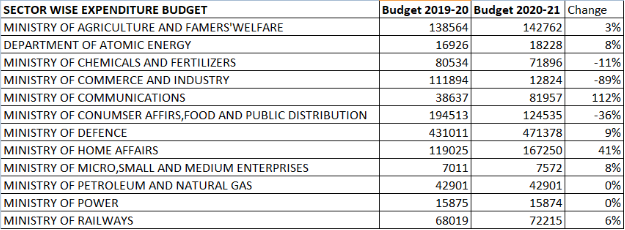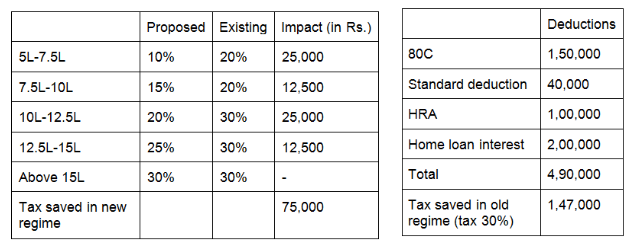- Government revised the fiscal deficit estimate to 3.8% for FY20 (earlier 3.3%). Further, the fiscal deficit is budgeted at 3.5% for FY21.
- Abolished dividend distribution tax for companies, and substituted it with a tax on recipients, depending on their income levels.
- In a step towards simplification of the tax structure, the budget proposed to remove around 70 of more than 100 income tax exemptions.
- Insurance for bank depositors has been increased to Rs 5 lakh per depositor from the current level of Rs 1 lakh per depositor.
- The national gas grid network to be expanded to 27,000 km from the existing 16,000 km.
- Government will sell part of its stake in LIC through IPO.
- Disinvestment target for FY21 raised to Rs 2,10,000 crore from Rs 65,000 crore (revised estimate for FY20).
Budget 2020 covered three themes – aspirational India, economic development, and building a caring society.
Theme 1: Aspirational India
- Agriculture sector
- Water, wellness, and sanitation
- Education sector
Theme 2: Economic development
- Indian railways
- Energy sector
Theme 3: A Caring Society
- Art & Culture
- Tourism sector
- Climate
Government prioritizes stimulus over fiscal discipline
In the moderating growth environment, the government did not hesitate to digest higher slippages in the fiscal deficit. The government triggered the “escape clause” under the fiscal responsibility and budget management (FRBM) act, which allows relaxation in the fiscal deficit trajectory during stressful scenarios. The government revised the fiscal deficit estimate to 3.8% for FY19-20 from an earlier budgeted estimate of 3.3%. Additionally, the fiscal deficit is now budgeted at 3.5% for FY20-21. Total expenditure is budgeted to grow at 12.7% and total receipts (ex-borrowing) are budgeted to grow by 11.6%. The non-tax revenue projection has been enhanced by about Rs 40,000 crore to Rs 3,85,017 crore. Also, the government has further raised expectations of proceeds from divestment to a new high of Rs 2,10,000. This looks optimistic, especially after the government lowered estimates of proceeds from divestment in FY19-20 to Rs 65,000 crore from an earlier estimate of Rs 1.05 lakh crore. However, disinvestments in BPCL, CONCOR, and other PSUs through CPSE ETF and BHARAT-22 ETF can help achieve higher disinvestment targets.

BE- Budget estimate, RE-Revised estimates, In INR crore
- On the revenue front, GST collection in January stood at Rs 1,10,828 crore where central GST accounted for Rs 20,994 crore and state GST(SGST) contributed Rs 28,224 crore.
- Further, according to the union ministry, GST revenue collection in January 2020 was the second-highest monthly collection since the inception of the new tax regime. Tax collection assumptions are based on the nominal GDP growth rate of 10%.
- There are 83 lakh (provisional) GSTR 3B returns for December filed till January 2020.
- Further, net borrowing for FY20 is pegged at Rs 4.99 lakh crore and Rs 5.36 lakh crore for FY21.
- Fuel subsidy allocation grew 6% y/y to Rs 40,915 crore, and fertilisers allocation was down 11% to Rs 71,309 crore.
Sector wise fund allocation

- The ministry of defense attracted the highest amount of funds at 38% of the total allocation, which was 9% higher than the last year.
- The highest increase in funds is seen in the ministry of communications, however, its overall share is at 7% of the total.
- The ministry of commerce, which accounted for 1% of total funds, saw the steepest decline of 89%.
Abolition of DDT is a welcome step:
The Decision: The finance minister abolished the dividend distribution tax imposed on companies and substituted it with a tax on shareholders, depending on their income levels.
Impact:
- This is a welcome step for the companies that give dividends.
- This step will enable a higher influx of foreign investment into these companies, as these investors would now get credit for the tax paid in their home country.
- Low income earning individuals will benefit due to their lower effective tax rate.
- However, for large retail investors, it may be a negative step as they might be taxed at the maximum rate.

Changes in Personal Income Tax Structure to empower the middle class:
New income tax rates are optional. Individuals have the option to choose to pay according to the existing tax structure or migrate to the new regime.
- The new tax structure is applicable only if you forego deductions like HRA, 80C, standard deduction, section 80D, LTA, interest on housing loan on the self-occupied property, among others.
- Individuals, who forego relief and exemptions, will benefit the most from the proposed tax structure.
- However, for individuals claiming reliefs & exemptions and earning above Rs 15 lakh per year, it would be wise to stay with the existing regime.
- In a step towards simplification of the tax structure, the budget proposed to remove around 70 of more than 100 income tax deductions.
- Those earning up to Rs 5 lakh continue without any tax liability.
- The government estimated Rs 48,000 crore revenue loss due to the income tax relief.
- Thus, the disposable income will see a gain of Rs 48,000 crore, which will boost the consumption of FMCG products. This is going to benefit FMCG, paints, and consumer discretionary, among others.
- Stocks of Interest: Dabur, Whirlpool, Jubilant Foodworks, and HUL
Government continues with its commitment of doubling farmers income:
- The government has dedicated Rs 2.83 lakh crore for agriculture & allied activities, irrigation, and rural development. This includes Rs 1.6 lakh crore for agriculture and irrigation activities, and the remaining Rs 1.23 lakh crore for rural development.
- The government has set the agriculture credit target at Rs 15 lakh crore for FY21 (from Rs 12 lakh crore in FY20), which will cover all eligible beneficiaries of PM-KISAN under the KCC scheme.
- “Kisan Rail” and “Krishi Udan” to be launched by the Indian Railways and ministry of civil aviation through a public-private partnership model.
- The government has announced its plan to integrate the financing of negotiable warehousing receipts (e-NWR) with e-NAM.
- The government has encouraged states to adopt clusters to focus on “one product one district,” which can boost marketing and export in the horticulture sector.
- The government launched a scheme PM KUSUM to cover 20 lakh farmers for standalone solar pumps and an additional 15 lakh farmers for solarised grid-connected pump sets.
- Mahatma Gandhi National Rural Employment Guarantee Scheme (MGNREGS) attracted Rs 61,500 crore in the current budget, which is a decline of 13% from the total estimated expenditure of Rs 71,001.81 crore in 2019-20.
Promoting Make In India:
- The government has increased the custom or import duty to 35% from 25% on footwear, while parts of footwear will now attract 20%, up from 15%. Stocks like BATA India can benefit from these announcements.
- The customs duty has been hiked on furniture goods such as seats, mattress support, lamps and lighting fittings to 25% from 20%. Additionally, toys like tricycles, dolls, and puzzles will see a levy of 60%, up from 20%.
- Stocks of interest: Bata India
Health & Wellness for All:
- Currently, there are 20,000 empanelled hospitals under Ayushman Bharat, and more are required in tier 2 and tier 3 cities.
- Proposal to start a medical college in district hospitals under the PPP mode, viability gap funding to be set up for setting up such medical colleges.
- The health sector received an allocation of Rs 69,000 crore for FY21 in the budget. Another Rs 3,000 crore was allocated for skill development of hospital staff.
- Government has allocated Rs 12,300 crore for the Swachh Bharat mission.
- Stock of interest: Divislab and Dr Reddy
Banking sector reforms:
- To increase a depositor’s confidence, insurance for bank depositors has been increased to Rs 5 lakh per depositor from the current level of Rs 1 lakh.
- The government announced its decision to sell equity holding in IDBI bank to private investors, which can support greater private capital requirements.
- There has been a proposal in the budget to make necessary amendments in the banking regulations act to strengthen cooperative banks to enable access to the capital and improve governance.
Strengthening infrastructure sectors:
- The government has stressed on expansion or addition of solar capacities and introduced its plan for rail electrification.
- Focus should be on stocks such as Shakti pumps, KSB Pumps, and Roto pumps.
- There is a proposal in the budget to develop five new smart cities, with the development of infrastructure that focuses on warehousing and clean drinking water.
- There has been an allocation of Rs 22,000 crore for power and renewable energy sectors.
- The government has launched the Jal Jeevan Mission to enable piped water supply to rural households. This has attracted Rs 11,500 crore in FY21, which will be a part of the Rs 3.6 lakh crore mission.
- Stocks in the business of manufacturing pipes, such as Astra poly, can benefit from this infrastructure push.
Railways Get a Boost:
- Tejas type trains to be increased on the routes connecting tourist destinations.
- High-speed trains between Ahmedabad and Mumbai shall be actively looked upon.
- Setting up of solar panels along the railway tracks on the land belonging to the railways.
- The 148km long suburban Bengaluru project will be implemented with a cost of Rs 18,600 crore. The union government will fund 20% and provide external funding assistance of up to 60%.
Gas Grid Gets to be expanded:
- The national gas grid will be expanded to 27,000 km from the existing 16,000 km.
- Reforms shall be announced to deepen gas markets, enable ease of transactions and transparent price recovery.
- Stocks to look out are IGL, MGL, Crompton Greaves.
Other Key Announcements:
- International bullion exchange to be set up in IFSC GIFT City.
- The investment limit of FPIs in corporate bonds will be increased to 15% from 9%.
- Government will sell part of its stake in LIC through IPO.
- A scheme to provide subordinate debt to entrepreneurs of MSMEs will be introduced.
- Government has asked the Reserve Bank of India to extend the debt restructuring window for MSMEs by a year to March 31, 2021.
- Government pension trust will be separated from PFRDA. Insurance stocks like SBI Life (-10.2%) and HDFC Life (-6.1%) were down today.
- Balance government holding in IDBI banks to be sold to private retail investors. The stock reacted positively to the announcement, up more than 10%.
- Proposed ₹30,757 crore for Jammu and Kashmir, and ₹5,958 for Ladakh for FY21.
What do you think? Please email us any questions or comments.
Disclaimer: Information contained herein is not and should not be construed as an offer, solicitation, or recommendation to buy or sell securities. It is for educational purposes only.
